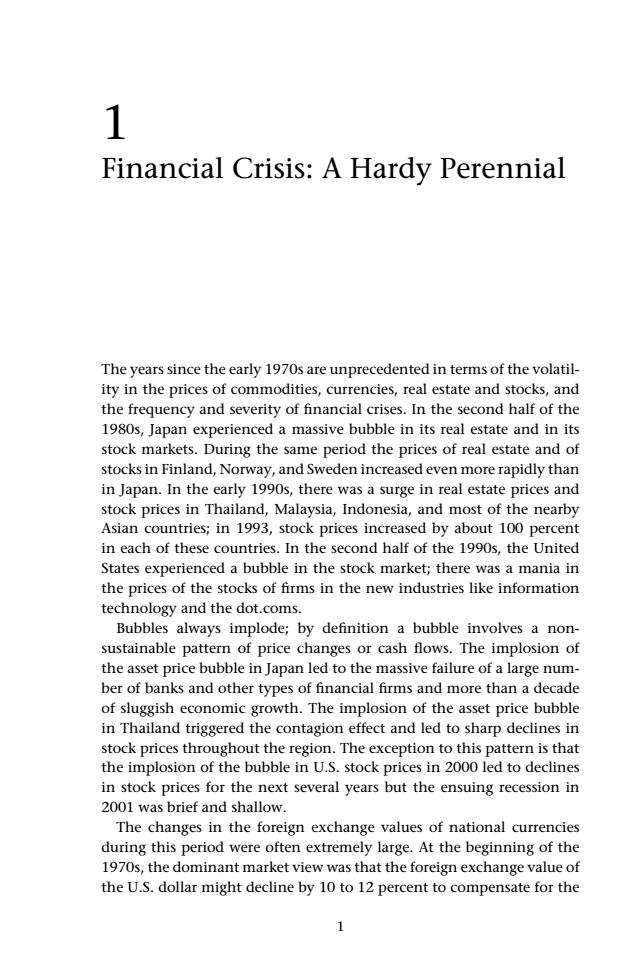正在加载图片...

1 Financial Crisis:A Hardy Perennial The years since the early 1970s are unprecedented in terms of the volatil- ity in the prices of commodities,currencies,real estate and stocks,and the frequency and severity of financial crises.In the second half of the 1980s,Japan experienced a massive bubble in its real estate and in its stock markets.During the same period the prices of real estate and of stocks in Finland,Norway,and Sweden increased even more rapidly than in Japan.In the early 1990s,there was a surge in real estate prices and stock prices in Thailand,Malaysia,Indonesia,and most of the nearby Asian countries;in 1993,stock prices increased by about 100 percent in each of these countries.In the second half of the 1990s,the United States experienced a bubble in the stock market;there was a mania in the prices of the stocks of firms in the new industries like information technology and the dot.coms Bubbles always implode;by definition a bubble involves a non- sustainable pattern of price changes or cash flows.The implosion of the asset price bubble in Japan led to the massive failure of a large num. ber of banks and other types of financial firms and more than a decade of sluggish economic growth.The implosion of the asset price bubble in Thailand triggered the contagion effect and led to sharp declines in stock prices throughout the region.The exception to this pattern is that the implosion of the bubble in U.S.stock prices in 2000 led to declines in stock prices for the next several years but the ensuing recession in 2001 was brief and shallow. The changes in the foreign exchange values of national currencies during this period were often extremely large.At the beginning of the 1970s,the dominant market view was that the foreign exchange value of the U.S.dollar might decline by 10 to 12 percent to compensate for thec01 JWBK120/Kindleberger February 13, 2008 14:58 Char Count= 1 Financial Crisis: A Hardy Perennial The years since the early 1970s are unprecedented in terms of the volatility in the prices of commodities, currencies, real estate and stocks, and the frequency and severity of financial crises. In the second half of the 1980s, Japan experienced a massive bubble in its real estate and in its stock markets. During the same period the prices of real estate and of stocks in Finland, Norway, and Sweden increased even more rapidly than in Japan. In the early 1990s, there was a surge in real estate prices and stock prices in Thailand, Malaysia, Indonesia, and most of the nearby Asian countries; in 1993, stock prices increased by about 100 percent in each of these countries. In the second half of the 1990s, the United States experienced a bubble in the stock market; there was a mania in the prices of the stocks of firms in the new industries like information technology and the dot.coms. Bubbles always implode; by definition a bubble involves a nonsustainable pattern of price changes or cash flows. The implosion of the asset price bubble in Japan led to the massive failure of a large number of banks and other types of financial firms and more than a decade of sluggish economic growth. The implosion of the asset price bubble in Thailand triggered the contagion effect and led to sharp declines in stock prices throughout the region. The exception to this pattern is that the implosion of the bubble in U.S. stock prices in 2000 led to declines in stock prices for the next several years but the ensuing recession in 2001 was brief and shallow. The changes in the foreign exchange values of national currencies during this period were often extremely large. At the beginning of the 1970s, the dominant market view was that the foreign exchange value of the U.S. dollar might decline by 10 to 12 percent to compensate for the 1